The iPad Air Review
by Anand Lal Shimpi on October 29, 2013 9:00 PM ESTDisplay
In building the iPad Air Apple shrunk all elements of the tablet’s design, including the thickness of the display. We’re still dealing with a 9.7-inch 4:3 2048 x 1536 IPS LCD panel with true RGB stripe rather than some weird subpixel structure. Viewing angles are still great, and overall the display remains the best you can get at this size.
![]()
The iPad Air continues Apple’s recent history of shipping color calibrated displays. Color accuracy on my iPad Air review sample is better than on any previous iPad I’ve ever tested, in fact it’s more accurate than any other tablet I’ve ever tested. The numbers are easily backed up by images that show a vibrant and, more importantly, accurate display.
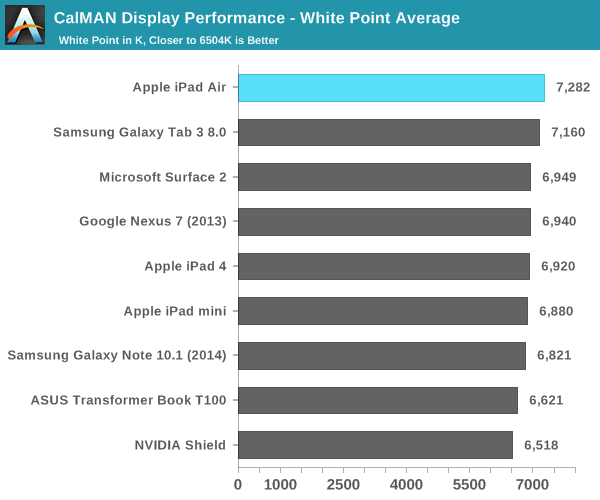
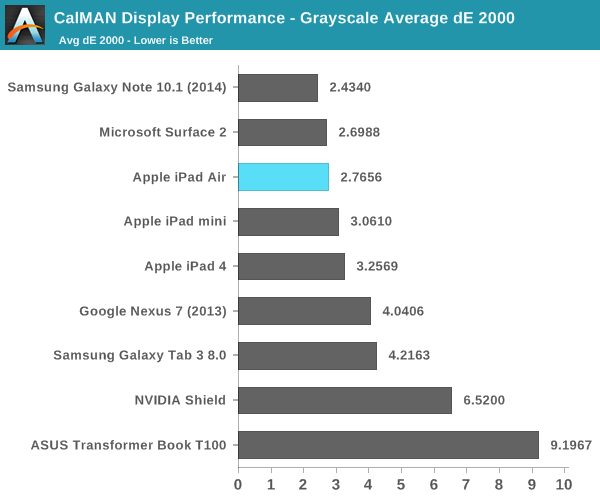
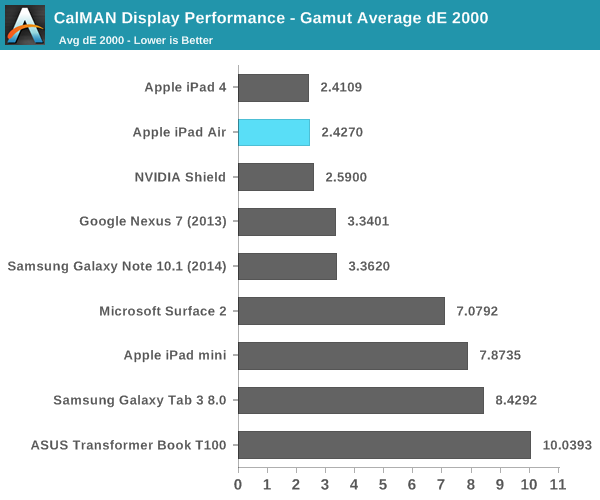



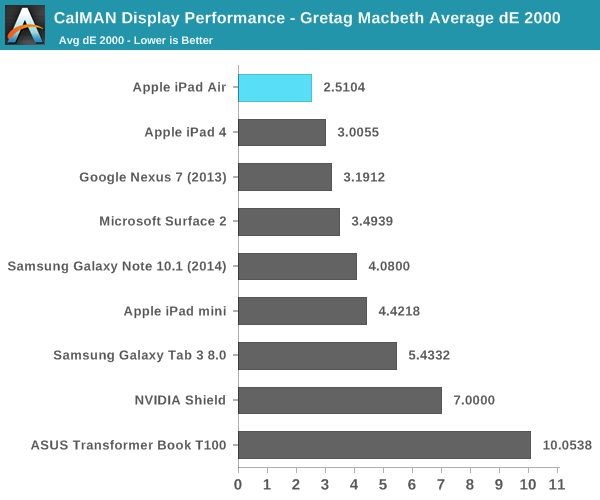

The iPad Air gets pretty bright at 426 nits, although black levels aren’t all that impressive at 0.44 nits. Overall contrast ratio is in line with what we’ve seen from previous iPads. My only complaint on the display front is I would like to see Apple laminate the cover glass to the LCD display. Reducing reflections would go a long way towards improving the usability of the device, not to mention the impact that would have on improving display quality in dark movie scenes.
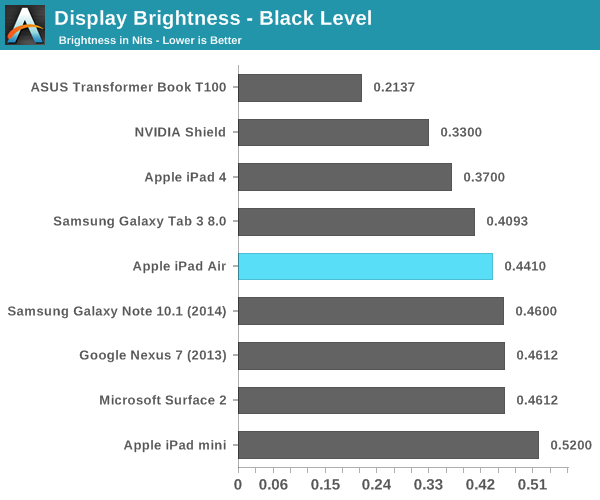
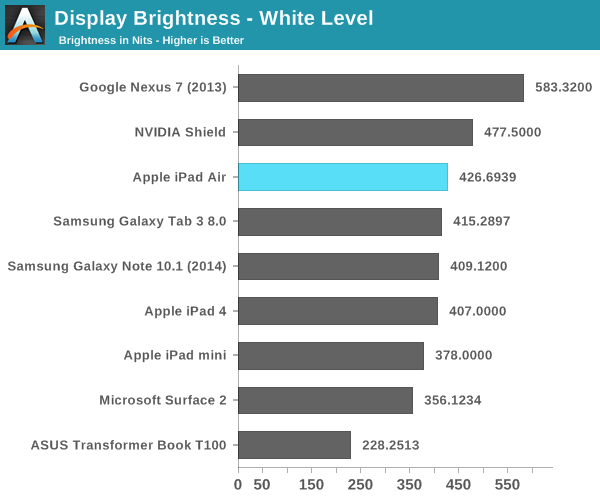
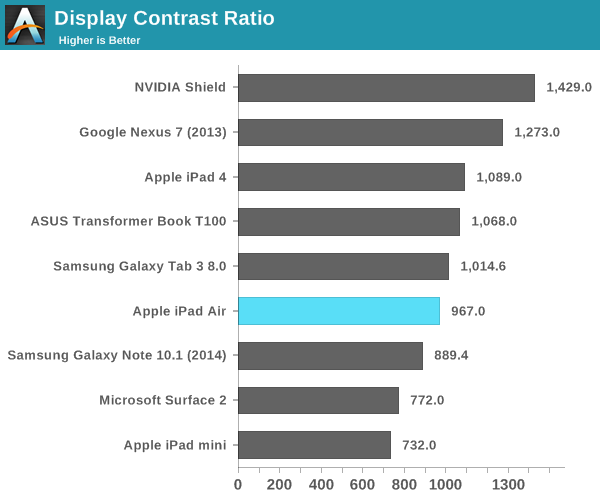















444 Comments
View All Comments
stingerman - Sunday, November 3, 2013 - link
Yes, I haven't even seen one of those in use other than commercials. Real failures...stingerman - Sunday, November 3, 2013 - link
lol, you're hilarious! iOS is Unix plus all the major OS X frameworks plus all the new iOS frameworks... It maybe light because of its elegance, but it's a light nuclear weapon...lilo777 - Sunday, November 3, 2013 - link
LOL. Do you know any version of Unix that does not have a file system (exposed to user)?Krysto - Friday, November 1, 2013 - link
Offtopic, but Anand, the announcement of Mali T760 is suspiciously missing from this site.Over 300 GFLOPS, which is more than PS3 and should make it pretty competitive with mobile Kepler, along with ASTC compression by default, much more efficient, and has some interesting features like hardware assisted global illumination.
ARM's announcement:
http://community.arm.com/groups/arm-mali-graphics/...
michael2k - Friday, November 1, 2013 - link
Yeah, the T700 series is for next generation devices, or in other words, products in the next 12 months. The PowerVR6 series is available now for this generation and up to 1000 GFLOPS.Krysto - Saturday, November 2, 2013 - link
Do you see that 1000 GBFLOPS in any smartphone? Just because it can be scaled that much, doesn't mean they WILL for smartphones. This GPU will be used in smartphones a year from now. What does the GPU in Apple's A7 have now? ~100 GFLOPS?Anyway, the Mali T760 seems very competitive with what will be out there a year from now, and Anandtech usually writes about these sort of announcements.
michael2k - Monday, November 4, 2013 - link
I think you've missed the point.1) We aren't in a smartphone thread
2) The PowerVR6 will scale to 1000 GFLOPs; so when the T700 comes out next year, the PowerVR will be ready
3) The Air is at about 115 GFLOPs, about 2x the outgoing iPad 4, and will therefore be approximately 230 GFLOPs in the A8 next year, if 2x, or 340 GFLOPs if 3x
So you are correct that the Mali T760 will be competitive next year, but this article is about this year.
michael2k - Monday, November 4, 2013 - link
You've missed the point.The PVR6 is 115GF today in the Air, and when needed to compete with the T700 can hit 300GF.
Likewise, we are in a thread about tablets, where it is much more likely to scale to the needed 300GF.
Krysto - Saturday, November 2, 2013 - link
What you said also reminded me of how Intel promoted "Haswell graphics"."Hey, look, out "Haswell GPU" (Iris Pro 5200) is 3x faster than IVB!" - and then you only see crappy 4600 in most devices, including the Surface Pro, which is only 20 percent faster than last year's IVB GPU.
Or "look at our awesome new 2.6 Ghz Silvermont CPU's! - and then you only see 1.3 ghz Silvemont for tablets, because the 2.6 Ghz ones are not viable either because of too high TDP or price, which makes them pretty irrelevant. What's relevant is what will be in the market, not their pie-in-the-sky CPU's that never get on the shelves.
ashleyuv - Saturday, November 2, 2013 - link
This is a very interesting review, even for someone without the tech or IT background to follow all of it. In particular, I like the way, in the last part, you show how the increase to 64-bit and the DRAM size (remaining the same), while seeming like a no-brainer and conservative decisions, respectively, are actually a smart play, albeit one with consequences.In agreement with one of your readers, I'd have to say that "review" is really the wrong word for this. It is all but a scientific study. But again, it's written for people who may not have an extensive tech background.
Thank you! I will be reading more in the future (just discovered your site).